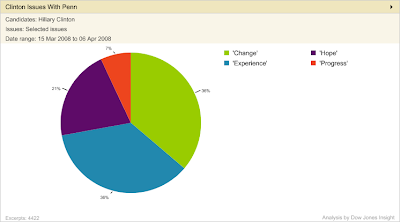Pati Carson
Dow Jones Insight Staff
Another topic where blog chatter about the Democratic candidates seemed to exceed, if not precede, mainstream media coverage was the economy.

 On the blogs, Obama’s name was mentioned in close proximity to words associated with the economy 1,228 times during March, far more often than Hillary Clinton’s 772. But in newspapers, the two candidates’ association with economic issues was nearly equal, with 4,823 for Obama and 4,751 for Clinton. (The respective totals are represented by the two bars in each chart marked “Barack Obama” and “Hillary Clinton.”)
On the blogs, Obama’s name was mentioned in close proximity to words associated with the economy 1,228 times during March, far more often than Hillary Clinton’s 772. But in newspapers, the two candidates’ association with economic issues was nearly equal, with 4,823 for Obama and 4,751 for Clinton. (The respective totals are represented by the two bars in each chart marked “Barack Obama” and “Hillary Clinton.”)
When considering headlines only – those cases in which one or the other of the candidates’ names was mentioned in a headline and in close proximity to economic terminology – Obama’s lead in blogs was even greater (853 for Obama to 267 for Clinton), while in newspapers the two were again quite close (3,694 vs 3,457). The disparity in blog headlines would seem to indicate that Obama was the intended focus of more posts, whether the context of those posts was positive or negative (and since this is the blogosphere, there were plenty of both).
The two candidates’ coverage in the analyzed period reflects speeches outlining their own economic plans, criticism of their rival’s plan, and questions about their position on NAFTA. Obama’s blog coverage was also bolstered by the many postings of his speech on race, which included several economic references, and comments about his speech linking the war in Iraq to U.S. economic problems.
Methodology: “Close proximity” is defined as within about 50 words. Sources in the analysis for Chart 3 include 3,135 unique posts from among 2 million of the most influential blogs, dated between March 1 and March 31. Sources in the analysis for Chart 4 include approximately 5,650 English-language newspapers and their related Web sites.















